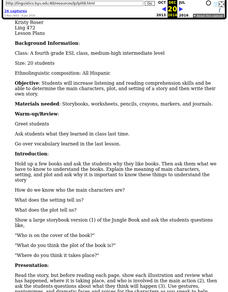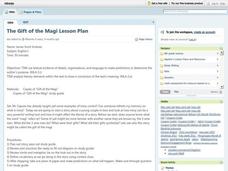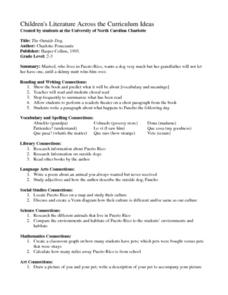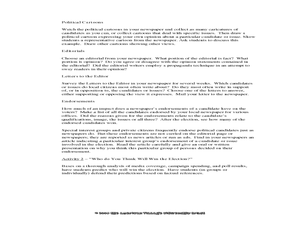Curated OER
What Is the True Story of the Three Little Pigs?
Cozy up and listen to a recording of The True Story of the Three Little Pigs and The Three Little Javelinas. Then, lead your class in a compare and contrast of the two stories by creating a Venn diagram.
Curated OER
The Mitten
Explore the Ukraine through a reading of The Mitten. Readers will determine the sequence of events, cause and effect, make predictions, and find the main idea of the story. They also use math skills to make charts and graphs. Finally,...
Curated OER
The Rest of the Story
Third graders make predictions about the story "The True Story of the Three Little Pigs" based on background knowledge. They read the story, stopping to verify or reject predictions. They write their own opinionated fairytales.
Curated OER
Where Do We Begin?
Primary learners grasp sequence of events by discussing morning routines and reviewing the story of Little Red Riding Hood. They explore the necessity of correct order of events. As a class, create a story with a beginning, middle, and...
Curated OER
Language Practice
The simple instructional techniques described in this plan will help young readers learn and practice basic reading skills and strategies. Before reading, introduce your readers to the meaning of main character, setting, and plot. Then...
Curated OER
Stone Soup
Students examine the topics of conflict, resolution, and solution using the book "Stone Soup." They create a class pictograph using real vegetables brought in by the students, answer story comprehension questions, and sequence the events...
Curated OER
Supporting Predictions With Text Evidence
Learners practice making and supporting a prediction with proof from a story. In this reading comprehension lesson, students read the book No Roses for Harry and make a prediction about the next event. Learners use evidence from the text...
Curated OER
Story Retellings
Second graders complete story maps in order to retell stories to the class.
Reed Novel Studies
Three Times Lucky: Novel Study
A car crash, a murder, a hurricane. With such a plot, why is the title of Sheila Turnage's novel Three Times Lucky? After making a prediction about the plot, scholars use the novel study to research and record facts...
Curated OER
Predictable Powers
Students use prior knowledge, the title, cover, and illustrations to make predictions about a story. They record their predictions on a Story Impression Worksheet, listen to the story, and check their predictions.
Curated OER
The Hat
Honing reading and communication skills through the theme of farm animals is the focus of this lesson. Students read a book about Scandinavian farm animals and complete prediction journal activities. They complete a worksheet about the...
Curated OER
Berlioz the Bear
Young children read the story, Berlioz the Bear and complete various reading and writing activities. They learn about fiction and non-fiction, and complete graphing and writing activities for the story. Youngsters draw the bear and use...
Curated OER
The Gift of the Magi
Test the true meaning of giving - and irony - with this lesson plan about "The Gift of the Magi." Using textual analysis, details, and text organization, middle schoolers make predictions about future events in the story and determine...
Curated OER
The Green Truck Garden Giveaway
Students read "The Green Truck Garden Giveaway" and explore the hobby of gardening. After observing illustrations in the book, students predict possible events in the story. They discuss gardening and write a story about a community...
Curated OER
What's Your Opinion
Students complete a questionnaire, formulating opinions on issues that be addressed in the novel, Sing Down the Moon. They make predictions about events that might occur in the novel based on the group discussion.
Curated OER
Muggie Maggie: Lesson 8
Students predict a chapter from a book while learning new vocabulary words. In this reading comprehension lesson, students read the book Muggie Maggie, and predict what will happen in the upcoming chapter. Students read and...
Curated OER
The Furry News: How to Make a Newspaper
Students investigate the process of making a newspaper using children's literature to create context for the lesson. The readers are asked to predict the events of the story as it is read to them. Then the teacher uses guided questions...
Curated OER
The Outside Dog
Students observe the book, "The Outside Dog," and predict the events of the story. At the conclusion of the story, students act out various paragraphs from the book and write about specified characters. Additional cross-curriculum...
Curated OER
The Island of the Skog
"Learners read "The Island of the Skog." Prior to reading, students observe the book cover, predict the events of the story, and discuss what a skog may look like. Learners make footprints in play dough and observe the differences...
Curated OER
Things Aren't Always What They Seem
Students use video and the Internet to make predictions, draw conclusions, determine conflict and point of view while reading a short story. In this short story analysis lesson, students watch a related video and complete a prediction...
Curated OER
Friendly Neighbors
Students identify the sequence of events in a text. In this literacy activity, students read the book Miss Tizzy and sequence the events from the text. Students reflect and write about the philanthropic acts in the book.
Curated OER
The Campaign: Issues and Strategies. What do you think?
Students research a candidate in an election and discuss how the media portrays that candidate and how the media influences voters. In this candidate lesson plan, students also distinguish fact from opinion, look at political cartoons,...
Curated OER
Writing a News Report
Students explore journalism by analyzing current events. In this news report lesson, students identify important questions to ask during an interview and discuss a fictitious news story about a missing teacher. Students read published...
Curated OER
Stories of Nepal
Students explore folktales and fairy tales from Nepal to help them understand the Nepalese culture, and to compare the stories to the ones the students may know. After reading the stories, students consider what rural life is like in...























